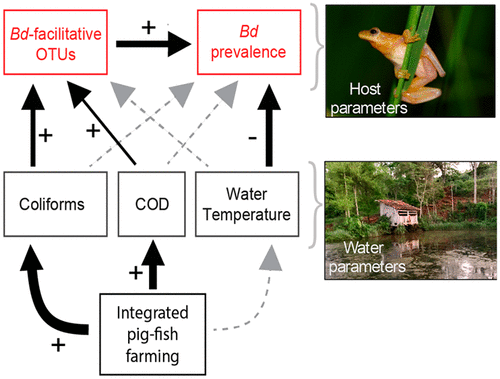当前位置:
X-MOL 学术
›
Environ. Sci. Technol.
›
论文详情
Our official English website, www.x-mol.net, welcomes your
feedback! (Note: you will need to create a separate account there.)
Widespread Pig Farming Practice Linked to Shifts in Skin Microbiomes and Disease in Pond-Breeding Amphibians.
Environmental Science & Technology ( IF 10.8 ) Pub Date : 2020-08-26 , DOI: 10.1021/acs.est.0c03219 Jackson F Preuss 1, 2 , Sasha E Greenspan 3 , Eliandra M Rossi 2 , Elaine M Lucas Gonsales 4 , Wesley J Neely 3 , Victor Hugo Valiati 1 , Douglas C Woodhams 5 , C Guilherme Becker 3 , Alexandro M Tozetti 1
Environmental Science & Technology ( IF 10.8 ) Pub Date : 2020-08-26 , DOI: 10.1021/acs.est.0c03219 Jackson F Preuss 1, 2 , Sasha E Greenspan 3 , Eliandra M Rossi 2 , Elaine M Lucas Gonsales 4 , Wesley J Neely 3 , Victor Hugo Valiati 1 , Douglas C Woodhams 5 , C Guilherme Becker 3 , Alexandro M Tozetti 1
Affiliation

|
Farming practices may reshape the structure of watersheds, water quality, and the health of aquatic organisms. Nutrient enrichment from agricultural pollution increases disease pressure in many host–pathogen systems, but the mechanisms underlying this pattern are not always resolved. For example, nutrient enrichment should strongly influence pools of aquatic environmental bacteria, which has the potential to alter microbiome composition of aquatic animals and their vulnerability to disease. However, shifts in the host microbiome have received little attention as a link between nutrient enrichment and diseases of aquatic organisms. We examined nutrient enrichment through the widespread practice of integrated pig–fish farming and its effects on microbiome composition of Brazilian amphibians and prevalence of the globally distributed amphibian skin pathogen Batrachochytrium dendrobatidis (Bd). This farming system drove surges in fecal coliform bacteria, disturbing amphibian skin bacterial communities such that hosts recruited higher proportions of Bd-facilitative bacteria and carried higher Bd prevalence. Our results highlight previously overlooked connections between global trends in land use change, microbiome dysbiosis, and wildlife disease. These interactions may be particularly important for disease management in the tropics, a region with both high biodiversity and continually intensifying anthropogenic pressures on aquatic wildlife habitats.
中文翻译:

广泛的养猪习惯与池塘池塘两栖动物皮肤微生物群系和疾病的变化有关。
耕作方式可能会重塑流域的结构,水质和水生生物的健康。农业污染造成的营养富集增加了许多宿主-病原体系统的疾病压力,但这种模式的机制并不总是能够解决。例如,营养物的富集应该强烈影响水生环境细菌库,这可能会改变水生动物的微生物组组成及其对疾病的脆弱性。但是,作为营养物富集与水生生物疾病之间的联系,宿主微生物组的变化很少受到关注。蛙壶菌(BD)。这种耕作制度推动了粪便大肠菌群的激增,扰乱了两栖动物皮肤细菌群落,使得宿主招募了更高比例的Bd促进细菌并携带了更高的Bd流行率。我们的结果强调了以前在土地利用变化,微生物组营养不良和野生动植物疾病的全球趋势之间被忽略的联系。这些相互作用对于热带地区的疾病管理尤其重要,热带地区既具有高生物多样性,又不断加剧水生野生生物栖息地的人为压力。
更新日期:2020-09-15
中文翻译:

广泛的养猪习惯与池塘池塘两栖动物皮肤微生物群系和疾病的变化有关。
耕作方式可能会重塑流域的结构,水质和水生生物的健康。农业污染造成的营养富集增加了许多宿主-病原体系统的疾病压力,但这种模式的机制并不总是能够解决。例如,营养物的富集应该强烈影响水生环境细菌库,这可能会改变水生动物的微生物组组成及其对疾病的脆弱性。但是,作为营养物富集与水生生物疾病之间的联系,宿主微生物组的变化很少受到关注。蛙壶菌(BD)。这种耕作制度推动了粪便大肠菌群的激增,扰乱了两栖动物皮肤细菌群落,使得宿主招募了更高比例的Bd促进细菌并携带了更高的Bd流行率。我们的结果强调了以前在土地利用变化,微生物组营养不良和野生动植物疾病的全球趋势之间被忽略的联系。这些相互作用对于热带地区的疾病管理尤其重要,热带地区既具有高生物多样性,又不断加剧水生野生生物栖息地的人为压力。


















































 京公网安备 11010802027423号
京公网安备 11010802027423号